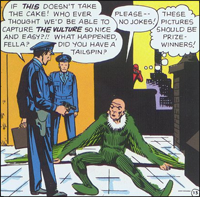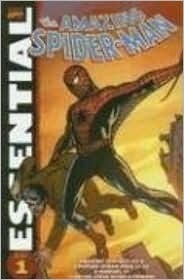Reading The Amazing Spider-Man: Issue Number Two Part One
It's time once again to glean the secrets of storyworld and story franchise creation by reading The Amazing Spider-Man! In this week's installment we tackle part one of issue number two: "Duel to the Death With the Vulture!"
This issue's splash page is less abstract than those found in issue one. High above the concrete and steel canyons of New York City, the amazing Spider-Man is ready to throw a punch as he keeps a firm grip on the ankle of an old, bald man in a green bird suit. The caption tells us…
The most colorful super-hero of all… Spider-Man! His name makes the under-world tremble! But there is one who does not tremble! What fantastic power can the Vulture have which makes him so sure he can defeat… Spider-Man?
I'm going to bet that fantastic power is… flight?
I'm more interested in the fact that, somewhere between the end of issue one, when Spider-Man was whining about nothing turning out right for him, and this splash page, the star of the comic apparently developed a reputation for frightening the bad guys.
How… when… did this happen? So far, the amazing Spider-Man has fought the burglar who killed his uncle and the Chameleon. Maybe both those guys have been talking in prison, and the word is spreading? Or has the amazing Spider-Man finally become a stalwart vigilante?
SynopsisLet's see. Turn the page, and we learn that a "new, awesome threat" is stealing briefcases full of bonds and whatnot from businessmen in broad daylight. He swoops down out of the sky "without a sound — without any effort" and the city's all a-tingle.
In fact, J. Jonah Jameson, head of Jameson Publications, wants to devote an entire issue of Now Magazine to the Vulture… but no one can get a decent picture of the swift, airborne bad guy.
Switch scenes to a "nearby high school," where Peter Parker (test tube in one hand while he takes notes with the other!) overhears his classmates gushing that a photo of the Vulture would be worth "a fortune."
You can almost see the dollar signs roll up behind Peter's big round glasses. He thinks,
Say! That's an idea! I never thought of it before! Magazines pay big money for hard-to-get photos! And I know how to get them!
Let's ignore Peter's entrepreneurial impulses for the moment, for some important stuff happens in the next panels.
First, a puffy-faced red-haired lad tosses his Now Magazine at our hero. The two exchange insults: the kid calls Peter a bookworm who can't read anything but scientific formulas; Peter declares his relief that at least his brain isn't muscle-bound "like that fat head of yours!"
We've just met Flash Thompson, the class bully who delights in tormenting Peter Parker even while he declares himself Spider-Man's biggest fan. Flash and Peter will have a long, complicated history, and it officially starts here.
Witty repartee finished for now, Peter pours over the magazine while daydreaming that the amazing Spider-Man could get close enough to take pictures of the Vulture and earn some money. He's so distracted, he ruins the experiment he was working on and gets chewed out by the teacher.
This is the first example of one of the major themes in The Amazing Spider-Man: the super-hero always gets in the way of Peter Parker's potential success in academia or, really, a steady professional life of any kind. Remember, Peter Parker is very, very intelligent. He's a brilliant molecular chemist, mechanical engineer and handy as a fabricator and he's not even sixteen years old. Without the distractions and driving guilt associated with his Spider-Man identity to repeatedly pull him off track, this is a kid who should go on to be a peer of Bill Gates or Stephen Hawking. Instead, as we'll see, he'll allow the red and blue costume to almost always come first. We'll return to this below.
Back to the story!
At home, Peter Parker gets a portable camera that belonged to his uncle, figures out a way to attach it to his costume, and heads into the city as the amazing Spider-Man. Meanwhile, the Vulture flies into town after learning that the Park Avenue Jewelry Exchange is moving "a million dollars worth of diamonds to their new offices across town."
He learns this in the newspaper. Because when you're moving a million dollars worth of diamonds, you want the whole world to know. Yeah.
In town, Spider-Man is fussing with his new camera when his "amazing spider senses" pick up something coming through the air. It's the Vulture, intent on a mission of bravado. He tosses notes through the windows of the Jameson Publishing Company, the radio network, and the police chief, all boasting that he will "steal the diamond shipment from under your noses!"
All this time, he's been followed by the amazing Spider-Man, who works on setting up his camera just behind where the Vulture has come to roost on a rooftop. Spider-Man is so intent on his photography, he makes a little too much noise. The Vulture takes to the air, flips behind Spider-Man, and kicks him unconscious.
Amazed that "this is almost too easy," the Vulture drops Spider-Man into a rooftop water tower so that "with Spider-Man out of the Way, the city will be mine!"
The cold water wakes up Spider-Man. He figures it's a simple matter to use his web to shoot a line to the top of the inside of the tower and climb out, but… guess what! He forgot to refill his web shooters! Just like last issue! D'oh!
No big deal, though. Spider-Man remembers he has the proportional strength of a spider, dives to the bottom of the tank, and just jumps out of the water tower. He even manages to retrieve his camera.
Back home, he discovers the pictures came out fine. He decides it would be a kick to sell them to J. Jonah Jameson, the man who hates Spider-Man. Then, he uses that big brain of his to make some practical modifications to his uniform — he redesigns his belt to hold additional web-fluid cartridges (this still won't stop him from running out when the plot calls for it) and works out a way to attach the camera to his belt buckle.
He's not done yet! It takes hours, but he cobbles together a little device to stop the Vulture. We have to assume he conceives, designs and fabricates this electronic gizmo from stuff he already had in his bedroom… you know, Erector Set parts, Radio Shack circuit board kits, and stuff. Just like the Chameleon's display of brilliance last issue, here is a person with remarkably talent… utterly misdirected.
The next day, J. Jonah Jameson (who already met Spider-Man during the affair with John Jameson's space capsule) meets Peter Parker for the first time. Peter sells Jonah his pictures of the Vulture, under the condition that Jameson never asks how Parker gets the pictures he takes and the photos are always simply credited to "a Now Magazine staff photographer."
It's the beginning of a beautifully complex relationship. The friction between Jameson, Parker and Spider-Man will fuel dozens of story arcs across the next forty years.
The day after that, after school, all the kids rush over to join the news media and watch the diamonds being moved. Everyone is waiting for the Vulture to makes his move. Police helicopters hover at the ready as the heavily escorted armored van makes its way across the city.
Peter ducks out so he can be ready for action, prompting Flash Thompson to caw,
Look, gang! Little Petey is chickening out! Guess the excitement is too much for his delicate little self!
As the jewels are transferred to the truck, the Vulture surprises everyone by attacking from underground — through a manhole! He snatches a briefcase full of diamonds and zips back below, where he uses the sewer tunnels to make his escape to the other end of town, taking to the air through a subway exit.
Peter Parker hears what happened and does a quick-change into the amazing Spider-Man. He's excited, because "if I can get some new pictures of him now, I'll be able to name my own price for them!"
The amazing Spider-Man's handy spider senses help him track the Vulture. They do a little cat and mouse, and Spider-Man grabs hold of the Vulture's ankle. The Vulture scoffs, "You fool! Here in the sky we're in my element!" but Spider-Man has a trick up his sleeve in the form of that little gadget he cooked up.
 Once it's activated, the Vulture can't stay aloft. He freaks out and spirals to the ground, while Spider-Man uses his web to swing to safety.
Once it's activated, the Vulture can't stay aloft. He freaks out and spirals to the ground, while Spider-Man uses his web to swing to safety.
A police helicopter spots where the Vulture has fallen, the wind knocked out of him. While the cops snicker about the Vulture having a tailspin, the humiliated villain gets the biggest laugh of the series so far when he begs, "Please — no jokes!" Hidden nearby, the amazing Spider-Man covertly snaps pictures of the whole affair.
The issue ends with almost nothing but positives for Peter Parker, the amazing Spider-Man. We learn the boy genius deducted that the Vulture used magnetic power to fly, which Peter thwarted with his gizmo, an anti-magnetic inverter. Peter gets so much money from J. Jonah Jameson for the Vulture pictures, he pays Aunt May's rent for a whole year and promises "tomrrow I'm buying you the newest kitchen appliances you ever drooled over!"
Can someone tell me what the rent on a small two bedroom house in Forest Hills, Queens would have been in 1963? Because… that seems like a heck of a lot of money. As we'll see, J. Jonah Jameson won't always pay so much for Peter's pictures, since Peter's perennial money problems are another trope of the series.
All in all, though… a rare good day for the amazing Spider-Man! The only cloud in this silver lining is the dour Vulture, who swears vengeance on our hero from behind bars.
Thoughts On Issue Two Part One of The Amazing Spider-ManAfter the bummer time of issue one of The Amazing Spider-Man (and, for that matter, Amazing Fantasy number 15), this first story in issue two comes up almost entirely aces for our hero… while establishing more foundation upon which future stories will be built. In thirteen pages, we get:
The first bona-fide appearance of Flash Thompson and the establishment of their rivalry.The first example of the Spider-Man identity sabotaging Peter Parker's success or progress in the real world.The beginning of Peter Parker and J. Jonah Jameson's relationship.The second animal-based bad guy in a row. Still to come are villains based on an octopus, a lizard, a rhino, a razorback hog, a fly, a cat, a dinosaur, a jackal, a tarantula, bees… there are so many animal-based villains for our animal-based hero to fight, one writer will work a rationalization into the plot. But that's hundreds of issues into the future…While I still don't buy that Stan Lee and Steve Ditko were deliberately setting up elements that would become easy go-to plot devices for future stories… you can when you plan your story worlds. The important thing happening here in these early issues of The Amazing Spider-Man is that opportunities for conflict are being introduced everywhere possible: Spider-Man's biggest fan is Peter Parker's biggest rival. Peter Parker chooses to sell his photographs to Spider-Man's most vocal enemy. And the biggest conflict of all: Peter Parker versus Spider-Man.
Self-sabotage is a big part of Parker's personality (say "part of Parker's personality" ten times, fast). We'll see the "specter of Spider-Man" cause girlfriends to break up with him, ruin his academic record, put his loved ones in danger, keep him just this side of the poor-house well into what should be responsible adulthood, and worse. As things go on, we have to wonder if Peter Parker prefers (there I go again with the helpless alliteration) to fail because — as the person responsible for the death of the man who loved him like a father — he doesn't deserve to succeed.
While this issue is a nice switch from the emotional roller-coaster we saw in the first issue of The Amazing Spider-Man, it's hardly representative of the status quo. Peter Parker, we will see, can't be happy for long. Granted, a happy Peter would make for a less entertaining story because no one wants to read "The Amazingly Content Spider-Man." But as creators, we have to dig deeply into our characters and understand why nothing ever goes quite right for them. Many times, the reason will be some outside force or influence. I recommend making sure the character is also, at least to a degree, in their own way as well.
Let's talk about this in the comments: name a main character from a story franchise — books, comics, movies, television, whatever you like — with a powerful external force to struggle against and a deeply ingrained personal issue that proves almost as detrimental to that character's success or even survival. Discuss!
The Amazing Spider-Man number two part one
"Duel to the Death With the Vulture!"
Cover Date: May, 1963
Script: Stan Lee
Art: Steve Ditko
Lettering: John Duffy
Click the cover to buy the first twenty issues of The Amazing Spider-Man in an inexpensive trade paperback from Barnes & Noble Booksellers:


Your purchase helps support this series and all my creative endeavors — thanks!
Matthew Wayne Selznick - Telling stories with words, music, pictures and people.










